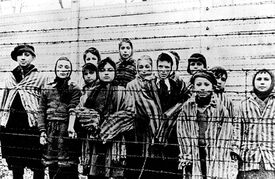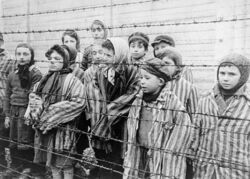Miriam Friedman / Miriam Ziegler (F / Poland, 1935), Holocaust survivor
Miriam Friedman / Miriam Ziegler (F / Poland, 1935), Holocaust survivor.
- <Poland> <Auschwitz> <Mengele Twins> <Liberation of Auschwitz> -- <Krakow Orphanage> -- <Austria> <Canadian Orphans>
Biography
Miriam Friedman was born May 21, 1935 in Radom, Poland, the only child of Rose and Hershel Friedman. Under Nazi occupation, Miriam for some time lived in hiding at various houses around Ostrowiec. Eventually, the family was deported to Auschwitz. Father perished. Miriam survived in the camp among the Mengele Twins until January 27, 1945, when the Red Army arrived. After recovering in a Polish orphanage in Krakow and then in Rapka, she was reunited with her mother, aunt and grandmother. The four of them made their way to Prague and Austria. In 1948, Miriam emigrated to Canada with a group of 1,000 children. Her mother and aunt arrived two years later. In 1957 Miriam married Holocaust survivor Roman Ziegler.
Auschwitz Picture
She is present in an iconic Auschwitz picture, that depicts 13 child survivors, shortly after the liberation of the camp. All of them have been identified. From left to right they are:
- (1) Tomy Shacham / Tomy Schwarz (M / Slovakia, 1933)
- (2) Miriam Friedman / Miriam Ziegler (F / Poland, 1935)
- (3) Pessa Balter / Paula Lebovics (F / Poland, 1933)
- (4) Ruth Muschkies / Ruth Webber (F / Poland, 1935)
- (5) Bracha Katz / Berta Weinhaber (F / Slovakia, 1930)
- (6) Erika Dohan / Erika Winter (F / Czechia, 1931)
- (7) Marta Wise / Marta Slonim (F / Slovakia, 1934)
- (8) Eva Slonim / Eva Weiss (F / Slovakia, 1931)
- (9) Gabor Hirsch (M / Poland, 1929)
- (10) Gabriel Neumann / Gabriel Nejman (M / Czechia, 1937-2012)
- (11) Shmuel Schelach / Robert Schlesinger (M / Czechia, 1934-2006)
- (12 & 13) Eva & Miriam Mozes / Eva Kor (F / Romania, 1934-2019) and Miriam Zieger (F / Romania, 1934-1993).
USF Shoah Foundation
During a drive from Radom, Poland, to nearby Ostrowiec in 1939 to visit her grandparents, Miriam Ziegler Friedman’s life changed forever.
Miriam, six years old at the time, came from a wealthy family that owned and operated several large clothing and general goods stores. But on that drive, Germans started shooting at the car she was riding in, and Miriam never returned to Radom. Instead, her cousin found a Polish farmer who agreed to let Miriam hide in his barn temporarily in exchange for money. The farmer would often take Miriam with him to beg door-to-door during the day – a world apart from the life of comfort she had known just a few months before.
Miriam’s parents were forced to work at nearby factories and building sites, but they tried to keep Miriam hidden as long as possible at various houses around Ostrowiec. Her safety, however, was far from guaranteed. At one house in the Ostrowiec ghetto, she hid in the attic as every other Jew inside was shot by police. She also saw the bodies of her own cousins hung near the forest outside the town.
Eventually, her parents smuggled her into the Ostrowiec concentration camp with them, where she hid in the latrines with other children to avoid being discovered since children were not allowed in the camp. In 1944, when Miriam was nine years old, everyone in the camp was put on cattle cars and sent to Auschwitz.
Miriam was separated from her mother and other family members but managed to survive with other children until Auschwitz was liberated in January 1945. Sick with tuberculosis and an eye infection, she was sent to a series of children’s homes in Poland to recover. With no idea where her family was or if they were alive, she left a note at the train station in Krakow with her name and the names of her parents and grandparents, hoping they would find her. In fact, an old friend from their hometown saw the note and told Miriam’s mother, who came to the children’s home to reunite with her daughter. After spending time recovering in Austria, in 1948 Miriam was able to immigrate to Toronto, Canada, where she went to high school. Though her mother soon joined her, Miriam worked after school and during the summer at a bakery and a toy factory to support them.
After graduation, Miriam worked as a bookkeeper. Friends set her up on a blind date with a fellow Holocaust survivor, Roman Ziegler, whom she married in 1958. They had three children, Stuart, Adrienne and Debbie, and Miriam worked part-time in clothing stores and sold clothes to friends out of her basement. She is now a grandmother. Miriam still keeps in touch with Paula Lebovics and Ruth Muschkies Webber, who are pictured in the photograph.

